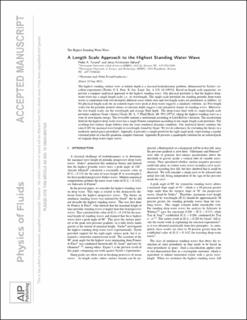| dc.description.abstract | The highest standing surface wave at infinite depth is a classical hydrodynamic problem, illuminated by Taylor’s ex- cellent experiments [Taylor, G. I., Proc. R. Soc. Lond. Ser. A 218, 44 (1953)]. Based on length scale arguments, we present a compact analytical approach to the highest standing wave. Our physical postulate is that the highest deep- water wave has a single length scale, i.e., its wavelength. The single-scale postulate for standing periodic deep-water waves is confronted with two distinctly different cases where zero and two length scales are postulated, as follows: (i) No physical length scale for an isolated rogue-wave peak at deep water suggests a similarity solution. (ii) Two length scales for the periodic peaked surface at constant depth suggest a one-parameter family of standing waves. Moreover, the two length scales are the wavelength and average fluid depth. The deep-water limit with its single-length scale postulate confirms Grant’s theory [Grant, M. A., J. Fluid Mech. 60, 593 (1973)], taking the highest standing wave as a state of zero kinetic energy. The reversible motion is irrotational according to Lord Kelvin’s theorem. The acceleration field for the highest deep-water wave has a single Fourier component according to our single length scale postulate. The resulting free-surface shape follows from the exact nonlinear dynamic condition. Our analytical theory confirms the ratio 0.203 for maximal wave height to wavelength, found by Grant. We test its robustness by extending the theory to a moderate spatial quasi-periodicity. Appendix A provides a simple proof for the right-angle peak, representing a regular extremal point of a locally quadratic complex function. Appendix B presents a quadrupole solution for an isolated peak of stagnant deep-water rogue waves. | |
